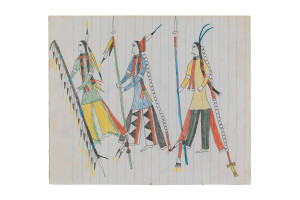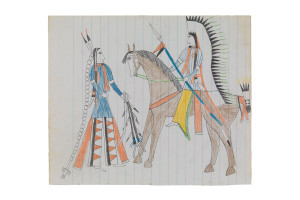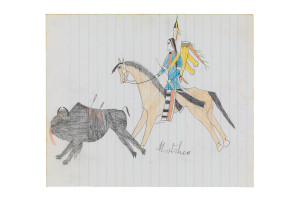
Ledger Drawing
attributed to Nah Hi Yurs (Carl Matches), d. 1914Matches Ledger Book
Southern Cheyenne
Central Plains
Plains Art Before 1850
Historically speaking, the term 'Plains Indians” refers to tribal groups originating in the Great Plains region of North America, a vast area of grasslands lying east of the Rocky Mountains and west of the Mississippi River. The Lakota, Cheyenne, Arapaho, Kiowa, Crow, Pawnee, Blackfeet and Comanche, among others, populated this area. Despite the lack of a written historical record prior to European contact, Plains peoples could claim a long tradition of recording personal and collective histories through oral and pictorial storytelling. The earliest historical records were the work of Plains Indian men who created petroglyphs and pictographic paintings on rock walls. Later, men painted on robes fashioned from buffalo hide, using mineral and vegetal pigments applied with bone and stick drawing implements. The scenes depicted were predominantly of status achievements such as success in battle, hunting, and “counting coup” on enemies, as well as “winter counts”, a form of calendar of the year’s activities. The images were highly representational displaying careful attention to the details of the events recorded. Buffalo hide tipi covers, shields and personal garments were likewise embellished with finely executed imagery bearing witness to battles, social and religious events, as well as individual visions and experiences. However with the systematic extermination of the buffalo herds after 1850, the practice of painting on buffalo hide gradually diminished. In its place were painting on muslin, canvas and commercially prepared hides, and perhaps most intriguing, the creation of artistic works on paper.
Ledger Art and the Reservation Period
The term “Ledger Art” derives from the lined accounting ledgers that became widely available to Plains Indian peoples in the reservation period, roughly after 1860. Pages from these ledger books were adapted artistically by Plains Indians, to create narrative paintings and drawings which were clearly an extension of earlier biographic and pictographic works in the earlier media. This new form of Plains Indian artistry was contemporaneous with, and arguably an adaption to the forced relocation of Plains Indian tribes onto government reservations, marking the end of traditional life based on the buffalo hunt. In the reservation period, the bone and stick implements and natural pigments previously used to paint on buffalo hides gave way to an array of newly available commercial products such as graphite, colored pencils, ink wash, crayon, watercolor paints and brushes. While the earliest ledger drawings continued the tradition of depicting military exploits and acts of personal heroism previously established in buffalo hide painting, changes occurred with the forced displacement of populations on to reservations. As the era of the warrior ended, the subject matter of ledger drawings gradually shifted from warfare and military exploits to scenes of ceremonial life, domestic hunting and courtship. In documenting these changes, Ledger Art is an invaluable chronicle of 19th century life and adaptation by Plains peoples.
A publication regarding Ledger Art is available here.
Status: All
Results: 466












High-resolution images available. Contact Gallery for rights.